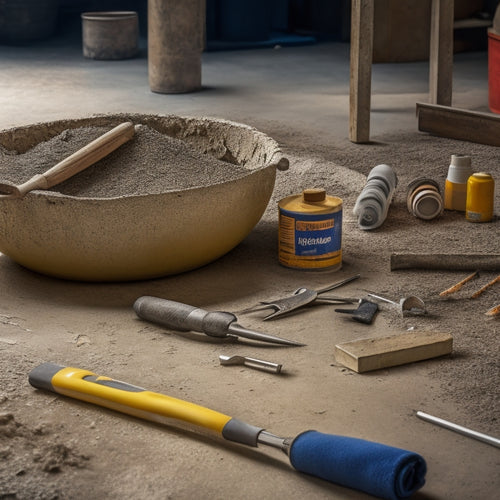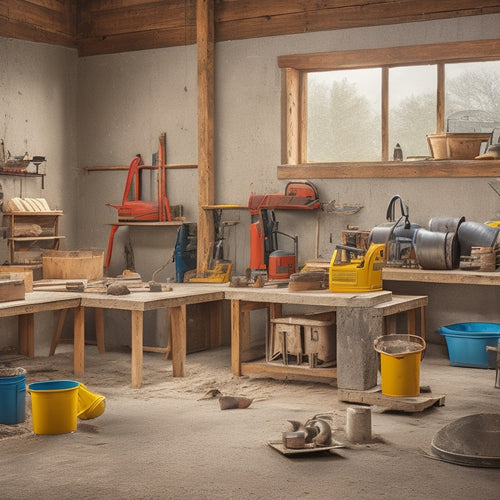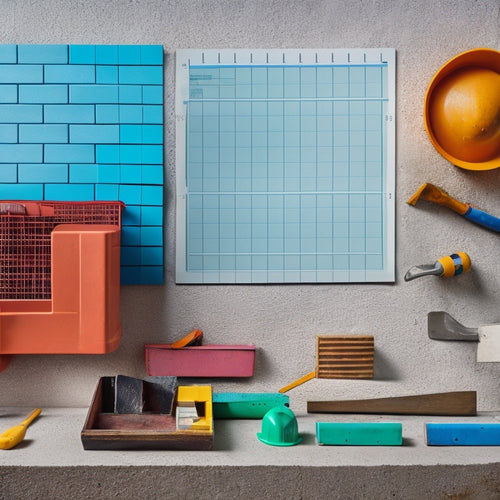
3 Best Tools for Building Concrete Blocks
Share
When building concrete blocks, you'll need three essential tools to guarantee accuracy, efficiency, and strong structures. First, a level assures accurate block alignment, which is vital for a solid foundation. Next, a trowel facilitates smooth and even mortar application, while a jointer compresses mortar to create solid bonds between blocks. With these three tools, you'll be well on your way to building strong and durable concrete blocks; now, explore the additional tools and techniques that can take your block-laying skills to the next level.
Key Takeaways
• A level ensures accurate block alignment, which is crucial for a strong structure.
• A trowel facilitates smooth and even mortar application, making the laying process more efficient.
• A jointer compresses mortar to create solid bonds between blocks, resulting in a more durable structure.
• A laser level projects precise level lines, ensuring blocks are laid level and plumb.
• Regular maintenance of tools, such as cleaning and storing them in a dry place, prevents mortar buildup and rust.
Essential Block Laying Equipment
You'll need a level, a trowel, and a jointer to secure accurate block alignment and smooth mortar application.
These vital tools will help you master block laying techniques and guarantee a strong, durable structure. A level guarantees your blocks are perfectly aligned, while a trowel allows for smooth, even mortar application. A jointer, on the other hand, helps create a solid bond between blocks by compressing the mortar.
To get the most out of your equipment, regular maintenance is essential. Clean your trowel and jointer regularly to prevent mortar buildup, and store them in a dry place to prevent rust.
Your level should be checked for accuracy periodically to ensure it remains calibrated. By keeping your equipment in top condition, you'll be able to work efficiently and effectively, producing high-quality results.
With these vital tools and proper equipment maintenance, you'll be well on your way to mastering block laying techniques and building a strong, long-lasting structure.
Compaction and Leveling Tools
Beyond block laying equipment, compaction and leveling tools play a vital role in guaranteeing a solid foundation and even surface for your concrete block structure.
You'll need the right tools to compact the soil and level the ground to prevent settling or shifting of the blocks. This is essential for maintaining the structural integrity of your building.
Here are the essential compaction and leveling tools you'll need:
-
Vibratory Plate: A vibratory plate compactor is ideal for compacting soil, sand, or gravel. It helps to remove air pockets and provides a stable base for your blocks.
-
Laser Level: A laser level guarantees that your blocks are laid perfectly level and plumb. It projects a precise level line, allowing you to adjust your blocks accordingly.
-
Hand Tamper: A hand tamper is a simple yet effective tool for compacting small areas or tight spaces. It's perfect for finishing work around edges or corners.
- Spirit Level: A spirit level is a must-have for guaranteeing your blocks are level and plumb during the laying process. It provides accurate readings and helps you make adjustments on the fly.
Safety and Measuring Essentials
As you prepare to lay concrete blocks, verifying your workspace is safe and your measurements are accurate becomes a top priority.
You'll need the right safety gear to protect yourself from potential hazards, such as gloves, safety glasses, and a dust mask. A hard hat and steel-toed boots are also vital for preventing serious injuries. Don't forget to wear knee pads to reduce fatigue and discomfort.
When it comes to measuring, accuracy is essential. You'll need a reliable tape measure and a level to make certain your blocks are aligned correctly. Consider investing in a laser level for more precise measurements.
Additionally, a chalk line reel will help you mark straight lines and patterns on your concrete slabs. Mastering measuring techniques, such as calculating the number of blocks needed and checking for square, will save you time and reduce waste.
Frequently Asked Questions
Can I Use a Regular Drill for Mixing Concrete?
When you're preparing to mix concrete, you might wonder if a regular drill will suffice.
While it's technically possible, it's not the most efficient or effective approach. Regular drills lack the torque and power needed for thorough mixing, leading to inconsistent results.
Instead, consider investing in a drill specifically designed for mixing concrete, such as a hammer drill or a mixing drill.
Employ techniques like slow, controlled revolutions to guarantee a strong, uniform mix.
How Do I Prevent Concrete Blocks From Cracking?
You'll want to prevent concrete blocks from cracking by understanding the common causes. Shrinkage, thermal changes, and poor curing techniques are typical culprits.
To avoid these issues, you'll employ prevention techniques like using the right mix design, controlling temperature and humidity, and applying a proper curing compound.
Additionally, make certain your blocks are adequately reinforced and not overworked during the mixing process.
What Is the Ideal Temperature for Laying Concrete Blocks?
When laying concrete blocks, you need to guarantee ideal laying conditions.
Temperature plays an essential role in this process. You'll want to aim for a temperature between 50°F and 70°F (10°C and 21°C) for perfect hydration and setting.
Avoid extreme temperatures, as they can affect the block's strength and durability. If it's too hot, the concrete may set too quickly, leading to cracks, while cold temperatures can slow down the curing process.
Can I Reuse Concrete Block Molds After They Dry?
You've got a million blocks to lay, but first, can you reuse those concrete block molds after they dry?
Absolutely! With proper mold maintenance, you can extend the mold's durability and reuse it multiple times.
Clean the mold thoroughly, apply a release agent, and store it in a dry place. This will guarantee the mold remains in top condition, allowing you to produce consistent, high-quality blocks.
Do I Need to Add Reinforcement to All Concrete Blocks?
When building concrete blocks, you'll need to determine if reinforcement is necessary for each block type. Not all blocks require it, but it's essential for structural integrity in load-bearing applications.
You'll want to evaluate reinforcement methods like rebar, fiber mesh, or even composite materials. Assess the block's purpose and the forces it'll withstand to decide if reinforcement is necessary.
Don't compromise on strength - add reinforcement where it matters most.
Conclusion
You've got the foundation laid, and now it's time to cement your knowledge with the right tools.
Building concrete blocks requires precision and efficiency, and with these three essential tools, you'll be on a roll.
Don't let your project crack under pressure - get a grip on the best equipment and you'll be building like a pro in no time.
Remember, when it comes to constructing concrete blocks, the right tools are the key to accessing a solid foundation.
Related Posts
-

Top Tools for Repairing Cracked Concrete Surfaces
When tackling a cracked concrete surface repair, you'll need the right tools to guarantee a durable fix. Start with e...
-

What Tools to Rent for a Concrete Home Reno
When tackling a concrete home renovation, you'll need to rent a variety of specialized tools to get the job done. For...
-

Reinforcement Tools Checklist for Concrete Block Walls
You'll need a range of reinforcement materials, including horizontal and vertical rebar, fiber mesh, and anchor bolts...


